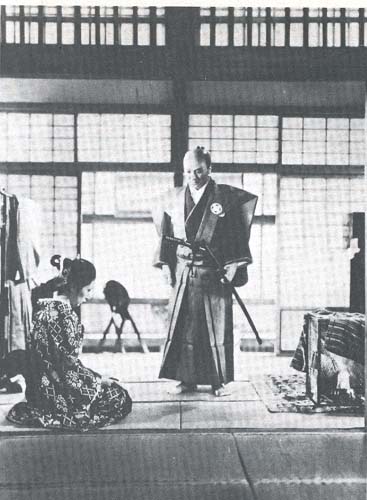
CLASS NOTES
FIRST WEEK: Mizoguchi's Loyal Forty Seven Ronin (Chuushingura)

Key Terms:
Cultural presupposition: what the creator of a work assumes the audience knows and need not be told.
Genres: Different cultures may have genres some of which may or may not exist in the West. The audiences may have different expectations about them.
Key Problems:
1. Should film be seen applying our own aesthetic judgment or trying to understand the cultural perception?
2.When seeing a single film, how much can we hold is universal, how much cultural, and how much
individual? For example, the Tokugawa period in films is prized by some directors, disliked by others,
and seen as neutral by other Japanese directors.
3. If we show a single film from a given genre, should that film be representative of the genre or "special": e.g.
if one were dealing with American films would the science fiction genre be "properly" represented by
2001: A Space Odyssey? Or dramas by Citizen Kane?
4. How do we fill in the cultural presuppositions that the author has left unsaid?
5. What are common themes represented in different Japanese films? Ninjo vs. giri; the role of "common
people"; women's position in society; nature and people's position in it, etc.
6. Language problems. Translation of dialogue, difficulty in remembering names of characters
7. Cultural problems: not knowing the social order; not knowing the value system; not being able to understand motivation.
8. Some writers have argued that people go to see American films for action, European films for character
development and Japanese films for atmosphere. How do the Japanese establish "atmosphere"?.
The Film: Mizoguchi's The Loyal 47 Ronin (Chuushingura) 1941
1. When the film was made in 1941, what conditions existed in Japan? (already involved with war in Asia.).
2. In jidaigeki (period) films, many use an early period of time to reflect on current (i.e. the time when the film
was made) conditions. How does this film do that? Does Mizoguchi endorse the Samurai Code? What is his
attitude toward the shogunate? Does the shogunate represent the 1941 Japanese government?
3. Mizoguchi was trained as a painter and his films are generally very artistic in their composition and rhythms,
although they often seem static and somewhat boring to outsiders. How does Mizoguchi's camera work
reflect (a) his artistic background (b) his attitude toward the values of the story. Consider particularly the
organization of the shots; the movement of the camera; the editing.. One scene one shot. Some western
critics thought it experimental (Griffith had given it up years before) Gives unity to scene, and also a sense of
reality since the camera eye is an observer and is not shifting there position throughout the scene. Mizoguchi
called his pictures shashin a word commonly used for photograph and in the case of movies is a shortened
form of katsudo shashin ("action photos", an old term for movies some feel is close to English "flickers").
Perhaps on some way it indicates a stress on the photo rather than the action. Mizoguchi felt if you are going
to make film, the picture should convey the story.
4. What is the impact of cultural presupposition on this film? (i.e. almost all Japanese know this story very
well). Hence Mizoguchi's ideas as to WHAT specific events to show and NOT to show becomes significant.
Return to Main Page
Return to Outline
Return to Films
Return to Classnotes
Click on the title of the film for notes on that film: